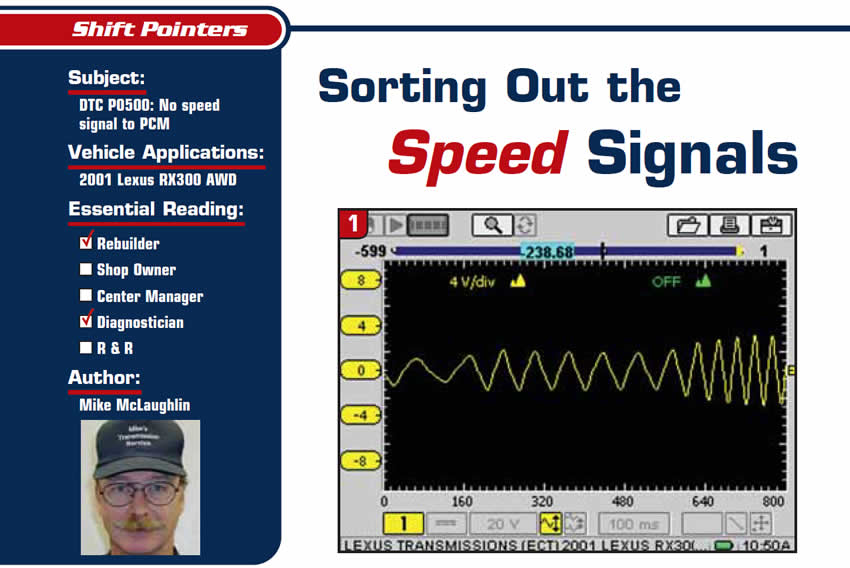
Shift Pointers
- Subject: DTC P0500: No speed signal to PCM
- Vehicle Application: 2001 Lexus RX300 AWD
- Essential Reading: Rebuilder, Diagnostician
- Author: Mike McLaughlin
Here’s a diagnostic situation that can sometimes lead us around in circles. On a 2001 Lexus RX300 AWD, we had a DTC P0500 and no speedometer operation, and the Check Engine and Vehicle Stability Control (VSC) lights were on.
Why can it sometimes lead us in circles? Because it’s not your normal vehicle-speed-signal theory of operation. It takes three different types of signals to end up with what the modules need to see for them to all be happy, function properly and not set codes.
One of the first things to focus on is the actual meaning of the DTC P0500 for this vehicle, which is no speed signal sent to the powertrain control module (PCM). On the original road test, we verified the symptoms mentioned and tried to plan our approach to diagnosing and repairing the problem.
A few things to note right at the start include that the vehicle seemed to drive OK and there was no antilock-brake-system (ABS) light on, plus there were no other codes. There was also no speed-signal reading from the PCM on the scan tool. As a quick check, we switched to the ABS module, and all wheel-speed sensors were reading correctly in the ABS module according to the scan tool.
The first signal needed, and where it all originates, is the right-front wheel-speed sensor (WSS). This is just a two-wire AC generator like almost any WSS. These signals can be checked at the WSS or, an even better place to check, right at the ABS/VSC module. Lexus actually calls this module or electronic control unit (ECU) an Antilock Brake System/Brake Assist/Traction Control/Vehicle Stability Control ECU, or ABS/BA/TRAC/VSC ECU. The short name for our purposes here will simply be ABS/VSC module.
We also needed to check the signals at the PCM and ABS/VSC modules, so performing these checks right at the modules, which are right beside each other behind the glove box, was the best way to test. If you check right at the module, it can prove that a good signal gets to the module from the sensor through the harness. What you should see is a good sine wave as the wheel turns, just like what you see when checking any normal WSS or a normal-style VSS or AC pulse generator. This one was good at the ABS/VSC module, back-probed at the ABS/VSC-module connector. Figure 1 shows a good signal from the right-front WSS as the wheel begins turning from a stop.
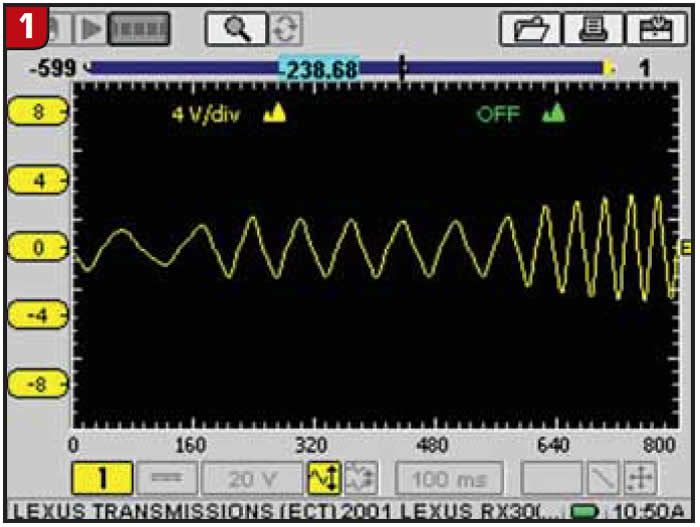
The ABS/VSC module then converts this signal to a DC pulsed signal through its AD (analog-to-digital) converter. This converted pulsed signal is then sent to the combination meter (CM), or what we would normally call the instrument cluster. So you have the sine wave in and the pulsed square wave out.
The image in Figure 2 is with the wheel turning, so it shows the pulses. If the wheel were stopped, it would be a straight voltage line. What needs to be noticed here is that this is a pulsed 12-volt signal, which then is sent to the CM, not the PCM.
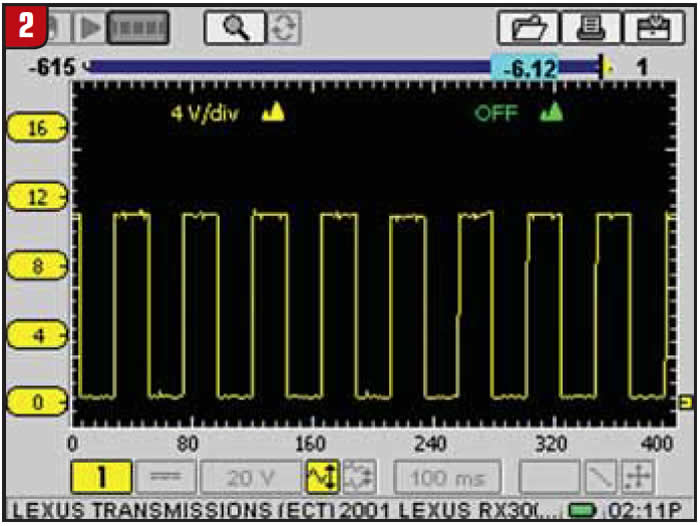
The CM has a module on the back of it that serves as a mini-computer or ECU for the meter. According to Lexus tech, the combination-meter module “refines” the waveform/signal sent from the ABS/VSC module and then sends it out. It goes to the PCM, navigation ECU, cruise control and multi-display unit (MDU) with one wire from the CM to a junction block, and the signal is dispersed to the other modules from there. Figure 3 shows a good signal sent out from the CM.
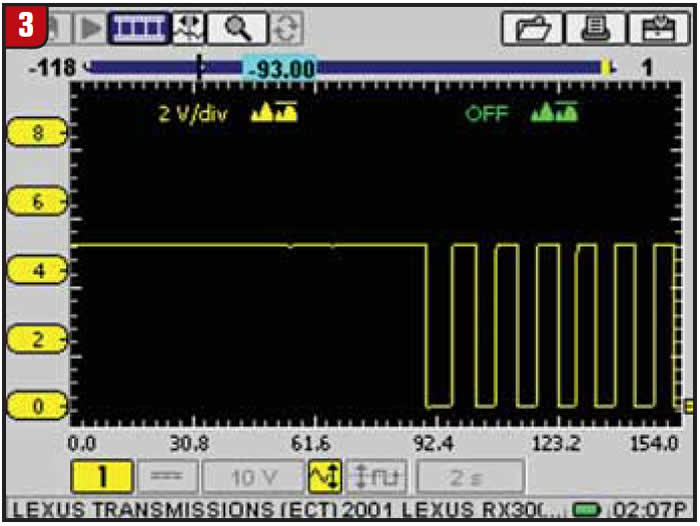
When the ignition is turned on you get a straight 5 volts, with no pulsed signal being sent from the ABS/VSC module. This is the CM sending a signal to the PCM at key on so the PCM knows the circuit is good and won’t set a P0500 as soon as the ignition is turned on and no real-time signal is sent until the vehicle moves. So the AC signal is sent to the ABS/VSC module from the WSS as the wheel turns. The ABS/VSC module converts the AC signal to a pulsed 12-volt DC signal and sends that signal to the CM. The CM then further converts the 12-volt pulsed signal into a 5-volt pulsed signal and sends that signal out of the CM on one wire to a junction block, where it’s dispersed to the other modules that need the speed signal. The big difference is that the CM now sends out a pulsed 5-volt signal rather than the pulsed 12-volt signal it received from the ABS/VSC module. When the wheel stops turning, there will be a zero-volt line, not the 5-volt reference, until the wheel turns again.
When we ran these tests to verify the good signals, Figure 4 shows what we found as the refined signal being sent from the CM to the PCM.
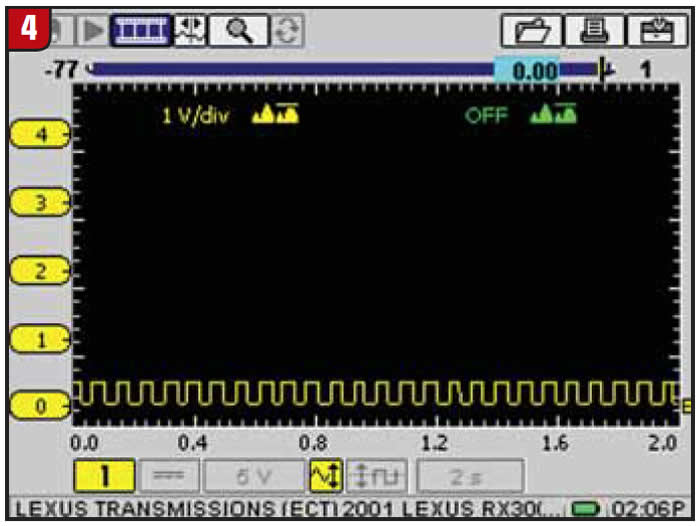
It was a pulsed signal but only about 1/2 volt, not 5 volts. This 1/2-volt pulse was not strong enough for any other module to make sense of it.
At this point, we figured the CM ECU was not sending out the correct speed signal to the other modules and needed to be replaced. We called the Lexus dealer and asked for a new CM assembly and specified that we wanted to be sure the CM ECU was included with the assembly. We also asked about the odometer requirements and were told that we would program the mileage after we installed the new CM assembly. A couple of days later we got a call and they needed to know the mileage, as the factory programs the mileage into the unit before it ships one. OK, no problem, just a longer delay.
Well, when the box arrived and we paid for our complete new mileage-programmed CM assembly, we got a surprise. Figures 5, 6 and 7 show what we received. This is the face panel with gauges and the CM ECU. This is what Lexus seems to consider a complete unit. Needless to say, that is a somewhat-frustrating situation, not because you have to disassemble and reassemble the entire assembly to install the boards but because there is a third circuit board in the CM that is not replaced, leaving room for doubt.
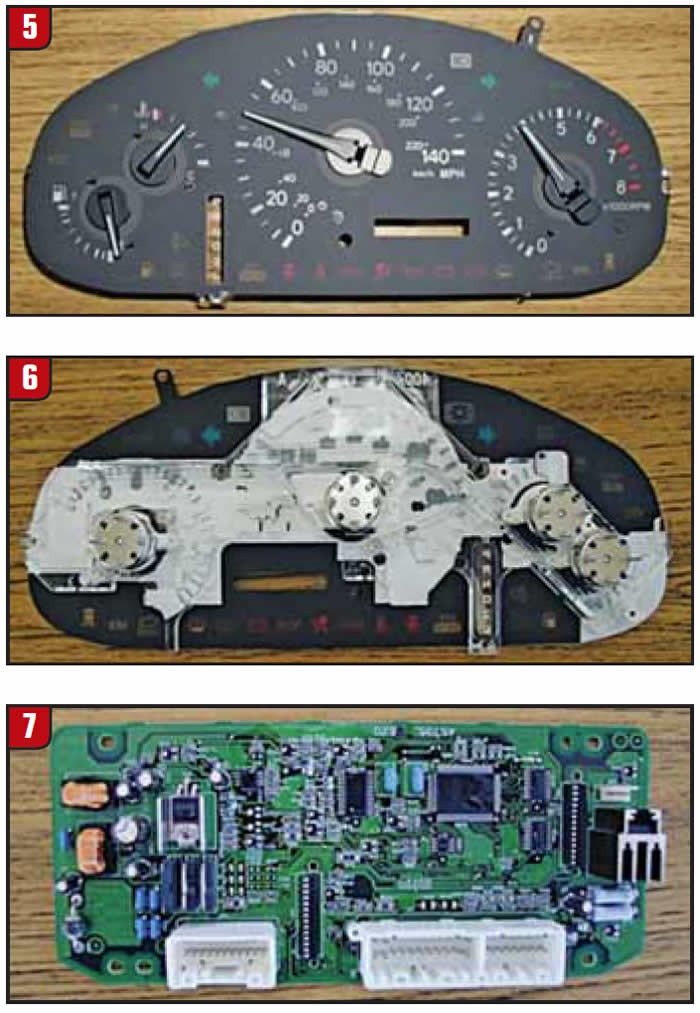
With the circuit boards replaced, we installed the now “rebuilt” CM assembly to see how well it was fixed. In this instance, it was not fixed quite enough. The vehicle now had a functioning speedometer, but we still got the P0500, the Check Engine and VSC lights were on, and there was no speed signal on the scan tool checking the PCM. Dang – all these diagnostics and a new CM, and it was only partly fixed. We retested the signal from the CM to the PCM and got the same darn thing (Figure 8).
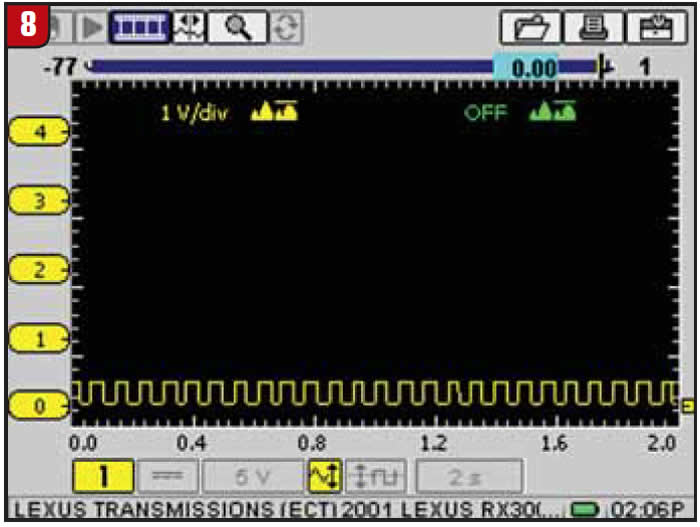
So, now we had to determine where our voltage had gone. We removed the MDU and the center of the dash to get to the J3 junction block, which splits up the speed signals, one in from the CM and four out: to the navigation ECU (NAV ECU), PCM, cruise control and MDU (Figure 9). We left the feed from the CM connected and cut out the NAV ECU and MDU so the signal would still be sent to the PCM and cruise-control modules. We checked these for shorts to ground while the wires were cut, and the NAV ECU showed to be shorted.
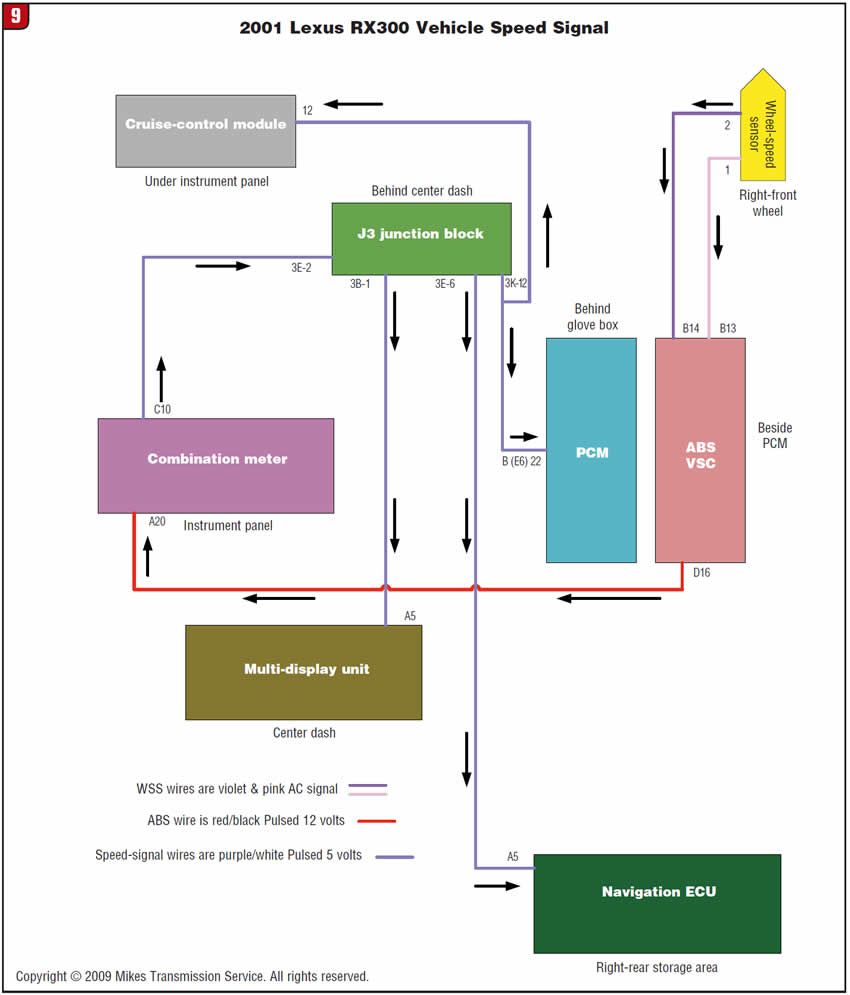
Anyway, we fired it back up and tried it and checked the signal at the PCM, with only the PCM and cruise control still in the circuit. Cool; we had a good signal at the PCM and no P0500. We tied back in the NAV ECU; it worked for about 15 seconds and then the signal dropped back out to a pulsed 1/2 volt. We unhooked that again and tried the MDU, and wow! It jumped to a pulsed 12 volts. I guessed I’d better not leave that connected for very long.
So now we were left with two different problems from two systems that were tied together. Well, we went and found the NAV ECU, which we hadn’t actually seen yet. Dang; it was under the spare-tire cover and side panel in the rear of the vehicle. Wouldn’t you know? The thing was full of water – corrosion and crap on the connectors and inside the NAV ECU. So at this point, we had the NAV ECU, MDU and radio all tied into one unit that was supposed to work as one.
What we really had was a NAV ECU that shorted out from being submerged in water inside the rear of the vehicle and let the smoke out of part of the MDU, in the meantime also letting some of the smoke out of the CM, which actually caused P0500.
So, rather than replace about $5,000 of electronics on a 2001 vehicle, by the customer’s choice we took the speed-signal wires out of the NAV ECU and the MDU, repaired our wire connections and, with the new CM circuit boards installed, sent it down the road with no warning lights on, a working speedometer, cruise control functional and a good speed signal to the ECU, so no more P0500. Even though the NAV unit and radio didn’t function properly, the customer was happy to have a properly working vehicle again.

Mike McLaughlin is the owner of Mike’s Transmission Service in Freeland, Mich.













